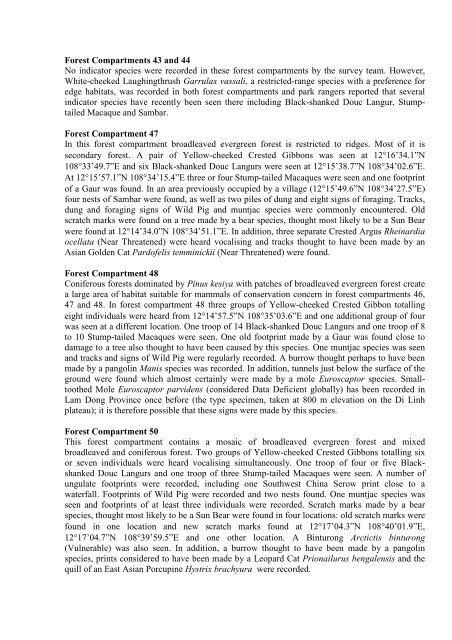a.TFF_rpt_on identification-planning - HCV Resource Network
a.TFF_rpt_on identification-planning - HCV Resource Network
a.TFF_rpt_on identification-planning - HCV Resource Network
You also want an ePaper? Increase the reach of your titles
YUMPU automatically turns print PDFs into web optimized ePapers that Google loves.
Forest Compartments 43 and 44<br />
No indicator species were recorded in these forest compartments by the survey team. However,<br />
White-cheeked Laughingthrush Garrulax vassali, a restricted-range species with a preference for<br />
edge habitats, was recorded in both forest compartments and park rangers reported that several<br />
indicator species have recently been seen there including Black-shanked Douc Langur, Stumptailed<br />
Macaque and Sambar.<br />
Forest Compartment 47<br />
In this forest compartment broadleaved evergreen forest is restricted to ridges. Most of it is<br />
sec<strong>on</strong>dary forest. A pair of Yellow-cheeked Crested Gibb<strong>on</strong>s was seen at 12°16’34.1”N<br />
108°33’49.7”E and six Black-shanked Douc Langurs were seen at 12°15’38.7”N 108°34’02.6”E.<br />
At 12°15’57.1”N 108°34’15.4”E three or four Stump-tailed Macaques were seen and <strong>on</strong>e footprint<br />
of a Gaur was found. In an area previously occupied by a village (12°15’49.6”N 108°34’27.5”E)<br />
four nests of Sambar were found, as well as two piles of dung and eight signs of foraging. Tracks,<br />
dung and foraging signs of Wild Pig and muntjac species were comm<strong>on</strong>ly encountered. Old<br />
scratch marks were found <strong>on</strong> a tree made by a bear species, thought most likely to be a Sun Bear<br />
were found at 12°14’34.0”N 108°34’51.1”E. In additi<strong>on</strong>, three separate Crested Argus Rheinardia<br />
ocellata (Near Threatened) were heard vocalising and tracks thought to have been made by an<br />
Asian Golden Cat Pardofelis temminickii (Near Threatened) were found.<br />
Forest Compartment 48<br />
C<strong>on</strong>iferous forests dominated by Pinus kesiya with patches of broadleaved evergreen forest create<br />
a large area of habitat suitable for mammals of c<strong>on</strong>servati<strong>on</strong> c<strong>on</strong>cern in forest compartments 46,<br />
47 and 48. In forest compartment 48 three groups of Yellow-cheeked Crested Gibb<strong>on</strong> totalling<br />
eight individuals were heard from 12°14’57.5”N 108°35’03.6”E and <strong>on</strong>e additi<strong>on</strong>al group of four<br />
was seen at a different locati<strong>on</strong>. One troop of 14 Black-shanked Douc Langurs and <strong>on</strong>e troop of 8<br />
to 10 Stump-tailed Macaques were seen. One old footprint made by a Gaur was found close to<br />
damage to a tree also thought to have been caused by this species. One muntjac species was seen<br />
and tracks and signs of Wild Pig were regularly recorded. A burrow thought perhaps to have been<br />
made by a pangolin Manis species was recorded. In additi<strong>on</strong>, tunnels just below the surface of the<br />
ground were found which almost certainly were made by a mole Euroscaptor species. Smalltoothed<br />
Mole Euroscaptor parvidens (c<strong>on</strong>sidered Data Deficient globally) has been recorded in<br />
Lam D<strong>on</strong>g Province <strong>on</strong>ce before (the type specimen, taken at 800 m elevati<strong>on</strong> <strong>on</strong> the Di Linh<br />
plateau); it is therefore possible that these signs were made by this species.<br />
Forest Compartment 50<br />
This forest compartment c<strong>on</strong>tains a mosaic of broadleaved evergreen forest and mixed<br />
broadleaved and c<strong>on</strong>iferous forest. Two groups of Yellow-cheeked Crested Gibb<strong>on</strong>s totalling six<br />
or seven individuals were heard vocalising simultaneously. One troop of four or five Blackshanked<br />
Douc Langurs and <strong>on</strong>e troop of three Stump-tailed Macaques were seen. A number of<br />
ungulate footprints were recorded, including <strong>on</strong>e Southwest China Serow print close to a<br />
waterfall. Footprints of Wild Pig were recorded and two nests found. One muntjac species was<br />
seen and footprints of at least three individuals were recorded. Scratch marks made by a bear<br />
species, thought most likely to be a Sun Bear were found in four locati<strong>on</strong>s: old scratch marks were<br />
found in <strong>on</strong>e locati<strong>on</strong> and new scratch marks found at 12°17’04.3”N 108°40’01.9”E,<br />
12°17’04.7”N 108°39’59.5”E and <strong>on</strong>e other locati<strong>on</strong>. A Bintur<strong>on</strong>g Arctictis bintur<strong>on</strong>g<br />
(Vulnerable) was also seen. In additi<strong>on</strong>, a burrow thought to have been made by a pangolin<br />
species, prints c<strong>on</strong>sidered to have been made by a Leopard Cat Pri<strong>on</strong>ailurus bengalensis and the<br />
quill of an East Asian Porcupine Hystrix brachyura were recorded.
















